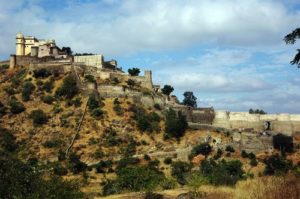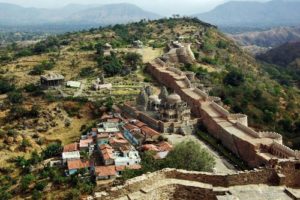Kumbhalgarh Fort is a massive walled city built in the 15thC on an impressive site on top of the Aravalli hills overlooking the plain. It was surrounded by a wall, 36km long and housed a population of 30,000 people in small villages scattered around the site. It makes the walled cities of York and Chester look like ant hills.
It was a pleasant drive from Narlai, across the plain and up through the hills of open deciduous forest with monkeys and babies sitting by the roadside, to the plateau with small villages and towns. The harvest had finished and there was little growing in the fields. Hay and dry sugar cane were stacked for winter feed. It had been a poor monsoon and everywhere was very dry. Water is stored in small dammed lakes, which were nearly empty. People were carrying water, often for long distances, from pumps.
There was a final climb up through a steep ravine to Kumbhalgarh. We could see the city wall snaking across hillside for miles. It was quite hazy when we arrived and the palace at the top of the fort was shrouded in cloud.
Kumbhalgarh was built in the 15thC by Maharana Khumbha and surrounded by a massive wall 36km long and wide enough on to for for eight horses. The walls are still intact and stand 15m high with bastions at regular intervals. They enclose temples, palaces, gardens and water storage facilities. At its height, it housed a population of 30,000 people. They were self sufficient in food and water and had enough to last for a year. It is thought it was only taken once, when the enemy poisoned the water supply.
The fort is protected by seven gateways with ramparts. The first gate was built some distance from fort and gave advance warning of potential danger. We parked inside the second gateway and walked through the third gateway into the main area. The palace was built on top of the hill to the left. Ahead was a small village, still lived in, and several temples to the right.
As the palace was still in cloud, we decided to visit the temples first starting with the huge Vedi Temple, which had a highly carved interior and steep steps to the upper levels and roof. From the roof we could see over the village settlement to the fields beyond with several more huge temple complexes. Locals were collecting fodder and firewood. A security guard followed us – we thought he was keeping an eye on us, but he had a key and opened up other temples for us to go inside. We climbed up to the palace complex along a steep path through more gateways each with a stout wooden door. The sun had now burnt off the cloud and the top was clear. We could see across the Aravalli Hills and the plain and began to get idea of just how large the fort was. The walls disappeared into the far distance enclosing many small villages and temples.
There was a noisy group heading to the main palace, so we went the opposite way and found the ruined Kumba Palace. This was a fascinating rabbit warren of rooms. The old woman in charge took us into a small shrine. It was very dark inside and took a long time for our eyes to adjust. We were given a long explanation, which we didn’t understand and a yellow spot was put on our forehead. A donation was expected but she understood and accepted my explanation that I was the wife with no money. Michael gave her 10r as we left which brought a smile. She was very concerned we didn’t miss other parts of Kumba Palace and there was much pointing.
The main palace is Badal Mahal Palace (Palace in the Clouds) and is a prominent landmark with its white painted walls. It is separated into Madrana (men’s) Palace and Zenana (women’s) Palace. We felt this was a bit disappointing after Kumba.
Only the Zenana Palace was open. The rooms are unfurnished and some of the rooms in Zenana have attractive painted friezes with elephants, crocodiles and camels. We climbed onto roof for views across hills and plains. Visibility was improving rapidly.
On the way back to Narlai we stopped in a small village to look at a clamp of bricks in the field. A ‘local guide’ based there came to talk to us. An old Rajasthani was sitting sitting outside his house. We were invited inside to look at his hand quern. We went through a large wooden doorway into an alleyway with two small goat kids scampering around and an electric potters wheel. They were very proud of this and we were shown how electricity was used to turn the wheel. There was a separate room behind with a mattress and the hand quern on the floor.
This had been a very well worthwhile and enjoyable day.









